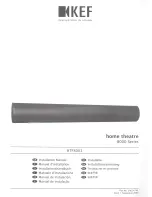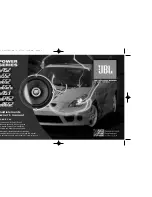
Part 1
New Construction Installation
1. This initial step should be completed after all structure framing is completed, and prior to
drywall installation. In this instance, a Pre-Construction Bracket Kit, such as MCM #50-
6680 (sold separately) must be utilized. These brackets mount to wall studs, and in
conjunction with drywall, provide a solid mounting base for the speaker. Compatible with
wood or metal studs spaced at standard 16” centers, the kit also includes extension rails
for studs mounted on 24” centers.
2. When positioning the pre-construction bracket between the studs, added care should be
taken to ensure that the bracket is level. A standard bubble level, such as MCM #22-
7572 or similar, model is essential to achieving this.
3. Centering the speaker opening between the studs, mount the Pre-Construction Bracket
to the studs.
4. If installing the speakers high on the wall, be sure to leave sufficient wire length at the
speaker end to reach to almost the floor. This greatly adds safety, as the speaker may
then be connected to the wire while standing on the floor instead on top of a ladder. Coil
the speaker wire and staple to the side of the stud above the bracket. Take care to
ensure that it does not interfere with drywall installation.
5. Once the drywall has been installed, a 9-5/8” (H) x 6-1/2” (W) opening should be cut to
match the hole in the pre-construction bracket. In most cases, the drywall installer will do
this at the same time that openings are cut for light switches, outlets and ceiling fixtures.
1. Skip directly to
Part 2
Installation in Completed Structures
1. For this type is installation, a stud finder such as MCM #22-6840 is highly recommended.
This device will not only accurately located both edges of the stud, but will provide a
warning of nearby electrical wiring.
2. When deciding on a final location to install in-wall speakers, extreme care should be
taken to ensure that obstructions do not exist, such as air ducts, plumbing and electrical
wiring.
3. Locate the wall studs between which the speaker will be mounted. Using a pencil, mark
a spot directly in the center of the two studs
4. Locate the rectangular cardboard mounting template, included with the speaker, and
using a tape measure, determine its exact center point.
5. Poke a small hole in the template, and place the template on the wall, lining up the hole
with the spot marked on the wall. At this stage, it is helpful to use masking or similar tape
to temporally attach the template to the wall. Using a standard bubble level, such as
MCM #22-7572 or similar, make sure the template is in proper position on the wall, and
lightly trace its outer edge with a pencil.
6. Remove the template, and using a wallboard saw similar to MCM #22-7597, cut along the
pencil mark. This type of saw is especially useful, as its rigid design and sharp point
allow it to “plunge” into the wall with no need to drill a pilot hole. When you have cut the
length of each edge, remove the saw, and start a new line, opposite the last cut edge.
This will ensure much cleaner cuts at the corners.























